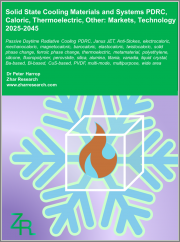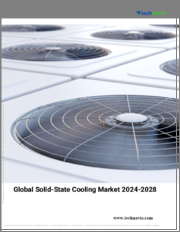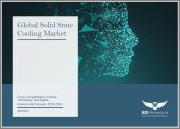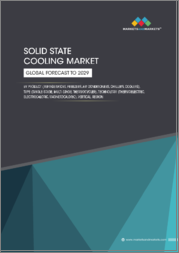
|
시장보고서
상품코드
1621422
세계의 고체 냉각 시장 : 제품 유형별, 최종 사용자별-예측(2025-2030년)Solid-State Cooling Market by Product (Cooling Systems, Refrigeration System), Type (Multi Stage, Single Stage, Thermocycler), End User - Global Forecast 2025-2030 |
||||||
고체 냉각 시장은 2023년에 8억 3,563만 달러로 평가되었고, 2024년에는 9억 2,566만 달러로 추정되며, CAGR 11.34%로 성장할 전망이고, 2030년에는 17억 7,298만 달러에 이를 것으로 예측됩니다.
급속히 상승하는 고체 냉각은 열전 효과, 자기 효과, 탄성 효과를 이용하여 가동 부품이나 냉매를 사용하지 않고 열을 전달하며 기존의 냉각 시스템보다 깨끗하고 조용하고 효율적인 대체 수단을 제공합니다. 고체 냉각 기술의 필요성은 기후 변화에 대한 우려가 높아지고, 하이드로플루오로카본 기반 시스템의 한계가 지적되고 있는 가운데, 에너지 효율이 높고, 환경 친화적인 냉각 솔루션에 대한 수요가 높아지고 있는 것으로부터도 분명합니다. 그 용도는 전자 기기의 냉각, 자동차의 공조 제어, 가전제품 등 다방면에 걸쳐 정확한 온도 제어와 에너지 소비의 삭감을 실현합니다. 최종 용도의 범위에서 가전, 헬스케어, 자동차, 산업 제조 등의 분야는 성능 향상과 에너지 소비 절감을 실현하는 이 기술의 혜택을 받고 있습니다. 시장 개척의 인사이트에 따르면 나노기술과 재료과학의 진보, 특히 뛰어난 효율을 가진 신규 서모 일렉트릭 재료의 개발이 성장의 원동력이 되고 있습니다. 사물인터넷(IoT)이나 기존의 냉각 시스템이 실용적이지 않은 소형의 웨어러블 디바이스에 대한 용도 확대가 기회입니다. 이를 활용하기 위해 기업은 전략적 파트너십과 연구개발 투자에 주력하며 기술 개발을 가속화해야 합니다. 그러나 초기 비용이 높고 기존 시스템에 비해 효율이 낮고 확장성 한계 등으로 인해 한계는 여전히 남아 있습니다. 주요 과제는 열전기 모듈의 재료 한계와 더 높은 냉각 능력의 필요성입니다. 성장이 기대되는 혁신적인 연구 개발 분야에는 특성을 향상시킨 새로운 열전 재료의 개발, 하이브리드 고체 냉각 시스템의 통합, 웨어러블 및 마이크로프로세서의 소형화 기술 등이 있습니다. 기술 진보의 페이스가 빠르고, 수많은 신흥 기업이 참가하고 있는 것을 특징으로 하는 이 시장의 경쟁의 격렬함을 이해하는 것은, 이 시장에서 성공을 목표로 하는 기업에 있어서 지극히 중요합니다. 환경 컴플라이언스와 병행하여 혁신과 효율 개선을 우선시함으로써 계속 진화하는 고체 냉각 속에서 비즈니스를 유리하게 진행할 수 있습니다.
| 주요 시장 통계 | |
|---|---|
| 기준년(2023년) | 8억 3,563만 달러 |
| 추정년(2024년) | 9억 2,566만 달러 |
| 예측년(2030년) | 17억 7,298만 달러 |
| CAGR(%) | 11.34% |
시장 역학 : 빠르게 진화하는 고체 냉각 시장의 주요 시장 인사이트 공개
고체 냉각 시장은 수요 및 공급의 역동적인 상호 작용을 통해 변모를 이루고 있습니다. 이러한 시장 역학의 진화를 이해함으로써 기업은 충분한 정보를 바탕으로 투자결정, 전략적 결정 정밀화, 새로운 비즈니스 기회 획득에 대비할 수 있습니다. 이러한 동향을 종합적으로 파악함으로써 기업은 정치적, 지리적, 기술적, 사회적, 경제적 영역에 걸친 다양한 리스크를 경감할 수 있을 뿐만 아니라 소비자 행동과 그것이 제조 비용 또는 구매 동향에 미치는 영향을 보다 명확하게 이해할 수 있습니다.
- 시장 성장 촉진요인
- 재료과학과 일렉트로닉스의 끊임없는 기술 혁신
- 환경 친화적이고 지속 가능한 기술의 중시 고조
- 의료기기에서의 정밀한 온도 제어에 대한 요구 증가
- 시장 성장 억제요인
- 냉각 능력의 기술적 한계
- 시장 기회
- 신재생 에너지 저장 분야에서의 새로운 용도
- 스마트 온도 제어 시스템을 위한 사물 인터넷(IoT) 기술 통합
- 시장의 과제
- 고체 냉각의 장점과 응용에 대한 인식과 이해 부족
Porter's Five Forces : 고체 냉각 시장을 탐색하는 전략 도구
Porter's Five Forces 프레임워크는 고체 냉각 시장 경쟁 구도를 이해하는 중요한 도구입니다. Porter's Five Forces 프레임워크는 기업의 경쟁력을 평가하고 전략적 기회를 탐구하는 명확한 기술을 제공합니다. 이 프레임워크는 기업이 시장 내 세력도를 평가하고 신규 사업의 수익성을 결정하는 데 도움이 됩니다. 이러한 인사이트를 통해 기업은 자사의 강점을 활용하고, 약점을 해결하고, 잠재적인 과제를 피할 수 있으며, 보다 강인한 시장에서의 포지셔닝을 보장할 수 있습니다.
PESTLE 분석 : 고체 냉각 시장에서 외부 영향 파악
외부 거시 환경 요인은 고체 냉각 시장의 성과 역학을 형성하는 데 매우 중요한 역할을 합니다. 정치적, 경제적, 사회적, 기술적, 법적, 환경적 요인 분석은 이러한 영향을 탐색하는 데 필요한 정보를 제공합니다. PESTLE 요인을 조사함으로써 기업은 잠재적인 위험과 기회를 더 잘 이해할 수 있습니다. 이 분석을 통해 기업은 규제, 소비자 선호, 경제 동향의 변화를 예측하고 앞으로 예상되는 적극적인 의사 결정을 할 준비를 할 수 있습니다.
시장 점유율 분석 : 고체 냉각 시장에서 경쟁 구도 파악
고체 냉각 시장의 상세한 시장 점유율 분석을 통해 공급업체의 성과를 종합적으로 평가할 수 있습니다. 기업은 수익, 고객 기반, 성장률 등 주요 지표를 비교하여 경쟁 포지셔닝을 밝힐 수 있습니다. 이 분석을 통해 시장 집중, 단편화, 통합 동향을 밝혀내고 벤더들은 경쟁이 치열해지는 가운데 자사의 지위를 높이는 전략적 의사 결정을 내리는 데 필요한 지식을 얻을 수 있습니다.
FPNV 포지셔닝 매트릭스 : 고체 냉각 시장에서 공급업체의 성능 평가
FPNV 포지셔닝 매트릭스는 고체 냉각 시장에서 벤더를 평가하는 중요한 도구입니다. 이 매트릭스를 통해 비즈니스 조직은 공급업체의 비즈니스 전략과 제품 만족도를 기준으로 평가하여 목표에 맞는 충분한 정보를 바탕으로 의사 결정을 내릴 수 있습니다. 네 가지 사분면을 통해 공급업체를 명확하고 정확하게 부문화하고 전략 목표에 가장 적합한 파트너 및 솔루션을 파악할 수 있습니다.
전략 분석 및 추천 : 고체 냉각 시장에서 성공을 위한 길을 그리기
고체 냉각 시장의 전략 분석은 세계 시장에서의 현장 강화를 목표로 하는 기업에 필수적인 요소입니다. 주요 자원, 역량 및 성과 지표를 검토함으로써 기업은 성장 기회를 파악하고 개선을 위해 노력할 수 있습니다. 이러한 접근 방식을 통해 경쟁 구도에서 과제를 극복하고 새로운 비즈니스 기회를 활용하여 장기적인 성공을 거둘 수 있는 체제를 구축할 수 있습니다.
이 보고서는 주요 관심 분야를 포괄하는 시장의 종합적인 분석을 제공합니다.
1. 시장 침투 : 현재 시장 환경의 상세한 검토, 주요 기업의 광범위한 데이터, 시장 도달범위 및 전반적인 영향력을 평가합니다.
2. 시장 개척도 : 신흥 시장의 성장 기회를 파악하고 기존 분야의 확장 가능성을 평가하며 미래 성장을 위한 전략적 로드맵을 제공합니다.
3. 시장 다양화 : 최근 제품 출시, 미개척 지역, 업계의 주요 진보, 시장을 형성하는 전략적 투자를 분석합니다.
4. 경쟁 평가 및 정보 : 경쟁 구도를 철저히 분석하여 시장 점유율, 사업 전략, 제품 포트폴리오, 인증, 규제 당국 승인, 특허 동향, 주요 기업의 기술 진보 등을 검증합니다.
5. 제품 개발 및 혁신 : 미래 시장 성장을 가속할 것으로 예상되는 최첨단 기술, 연구개발 활동, 제품 혁신을 강조합니다.
또한 이해관계자가 충분한 정보를 얻고 의사결정을 할 수 있도록 중요한 질문에 대답하고 있습니다.
1. 현재 시장 규모 및 향후 성장 예측은?
2. 최고의 투자 기회를 제공하는 제품, 부문 및 지역은 어디입니까?
3. 시장을 형성하는 주요 기술 동향 및 규제의 영향은?
4. 주요 벤더의 시장 점유율 및 경쟁 포지션은?
5. 벤더 시장 진입 및 철수 전략의 원동력이 되는 수익원과 전략적 기회는 무엇인가?
목차
제1장 서문
제2장 조사 방법
제3장 주요 요약
제4장 시장 개요
제5장 시장 인사이트
- 시장 역학
- 성장 촉진요인
- 재료과학 및 일렉트로닉스의 지속적인 혁신
- 환경 친화적이고 지속 가능한 기술에 대한 주목 고조
- 의료기기에서의 정밀 온도 제어의 필요성 증가
- 억제요인
- 냉각 능력의 기술적 한계
- 기회
- 신재생 에너지 저장 분야에서 새로운 용도
- 스마트 온도 제어 시스템을 위한 사물 인터넷(IoT) 기술 통합
- 과제
- 고체 냉각의 장점과 용도에 대한 인식 및 이해의 부족
- 성장 촉진요인
- 시장 세분화 분석
- 제품별 : 친환경 고체 냉각 시스템의 상승, 냉각 혁명
- 최종 사용자별 : 업계를 넘어서는 다양한 용도 범위
- Porter's Five Forces 분석
- PESTEL 분석
- 정치적
- 경제
- 사교
- 기술적
- 법률상
- 환경
제6장 고체 냉각 시장 : 제품별
- 냉각 시스템
- 에어컨
- 칠러
- 냉동 시스템
- 냉동고
- 냉장고
제7장 고체 냉각 시장 : 유형별
- 멀티스테이지
- 싱글 스테이지
- 서모사이클러
제8장 고체 냉각 시장 : 최종 사용자별
- 항공우주
- 자동차
- 소비자
- 헬스케어
- 산업
- 조사
- 반도체 및 일렉트로닉스
- 레이저 다이오드의 냉각
- 마이크로프로세서의 냉각
- 반도체 웨이퍼 프로브
제9장 아메리카의 고체 냉각 시장
- 아르헨티나
- 브라질
- 캐나다
- 멕시코
- 미국
제10장 아시아태평양의 고체 냉각 시장
- 호주
- 중국
- 인도
- 인도네시아
- 일본
- 말레이시아
- 필리핀
- 싱가포르
- 한국
- 대만
- 태국
- 베트남
제11장 유럽, 중동 및 아프리카의 고체 냉각 시장
- 덴마크
- 이집트
- 핀란드
- 프랑스
- 독일
- 이스라엘
- 이탈리아
- 네덜란드
- 나이지리아
- 노르웨이
- 폴란드
- 카타르
- 러시아
- 사우디아라비아
- 남아프리카
- 스페인
- 스웨덴
- 스위스
- 터키
- 아랍에미리트(UAE)
- 영국
제12장 경쟁 구도
- 시장 점유율 분석(2023년)
- FPNV 포지셔닝 매트릭스(2023년)
- 경쟁 시나리오 분석
- 지속 가능한 HVAC 기술의 선구자인 피에르 샤론의 혁신적인 TTAP 도입
- AirJet 기술을 탑재한 Zotac의 ZBOX PI430AJ 도입
- Exergyn의 지속 가능한 솔리드 스테이트 기술, 냉각에 혁명을 일으킨다
- 전략 분석 및 제안
기업 목록
- AMS Technologies AG
- Crystal Ltd.
- CUI Inc.
- EIC Solutions
- Everredtronics Ltd.
- Ferrotec Corporation
- Frore Systems
- HI-Z Technology Inc.
- HUI Mao Cooling Equipment Co. Ltd.
- II-VI Incorporated
- KELK Ltd.
- Komatsu Electronic Metals Co., Ltd.
- Kryotherm Company
- Laird Thermal Systems
- Phononic, Inc.
- RMT Ltd.
- Sheetak Inc
- Solid State Cooling Systems
- Sunamp Ltd.
- TE Technology Inc.
- TEC Microsystems
- Thermavance
- Thermonamic Electroni
The Solid-State Cooling Market was valued at USD 835.63 million in 2023, expected to reach USD 925.66 million in 2024, and is projected to grow at a CAGR of 11.34%, to USD 1,772.98 million by 2030.
Solid-state cooling, a rapidly emerging technology, leverages thermoelectric, magnetic, and elastocaloric effects to transfer heat without moving parts or refrigerants, offering a cleaner, quieter, and more efficient alternative to traditional cooling systems. The necessity of solid-state cooling technology is underscored by the increasing demand for energy-efficient and environmentally friendly cooling solutions amidst growing concerns about climate change and the limitations of hydrofluorocarbon-based systems. Applications span across electronics cooling, automotive climate control, and home appliances, providing precise temperature control and reducing energy consumption. In terms of end-use scope, sectors like consumer electronics, healthcare, automotive, and industrial manufacturing are prime benefactors due to the technology's ability to enhance performance and reduce energy needs. Market insights reveal that growth is fueled by advancements in nanotechnology and materials science, particularly in developing novel thermoelectric materials with superior efficiency. Opportunities lie in expanding applications in the Internet of Things (IoT) and compact, wearable devices where traditional cooling systems are impractical. To capitalize, businesses should focus on strategic partnerships and investments in R&D to accelerate technology development. However, limitations persist due to high initial costs, lower efficiency compared to traditional systems, and limited scalability. Key challenges include material limitations in thermoelectric modules and the need for a higher cooling capacity. Innovative research areas with promising growth potential include the development of new thermoelectric materials with enhanced properties, integration of hybrid solid-state cooling systems, and miniaturization techniques for wearables and microprocessors. Understanding the highly competitive nature of this market, characterized by fast-paced technological advancements and the entrance of numerous start-ups, is crucial for companies aiming to navigate it successfully. Prioritizing innovation and efficiency improvements, alongside environmental compliance, can position businesses favorably in the evolving landscape of solid-state cooling.
| KEY MARKET STATISTICS | |
|---|---|
| Base Year [2023] | USD 835.63 million |
| Estimated Year [2024] | USD 925.66 million |
| Forecast Year [2030] | USD 1,772.98 million |
| CAGR (%) | 11.34% |
Market Dynamics: Unveiling Key Market Insights in the Rapidly Evolving Solid-State Cooling Market
The Solid-State Cooling Market is undergoing transformative changes driven by a dynamic interplay of supply and demand factors. Understanding these evolving market dynamics prepares business organizations to make informed investment decisions, refine strategic decisions, and seize new opportunities. By gaining a comprehensive view of these trends, business organizations can mitigate various risks across political, geographic, technical, social, and economic domains while also gaining a clearer understanding of consumer behavior and its impact on manufacturing costs and purchasing trends.
- Market Drivers
- Continuous innovation in materials science and electronics
- Growing emphasis on eco-friendly and sustainable technologies
- Increasing need for precise temperature control in medical equipment
- Market Restraints
- Technical limitations for cooling capacities
- Market Opportunities
- Emerging applications in renewable energy storage sectors
- Integration of Internet of Things (IoT) technology for smart temperature control systems
- Market Challenges
- Lack of awareness and understanding of solid-state cooling benefits and applications
Porter's Five Forces: A Strategic Tool for Navigating the Solid-State Cooling Market
Porter's five forces framework is a critical tool for understanding the competitive landscape of the Solid-State Cooling Market. It offers business organizations with a clear methodology for evaluating their competitive positioning and exploring strategic opportunities. This framework helps businesses assess the power dynamics within the market and determine the profitability of new ventures. With these insights, business organizations can leverage their strengths, address weaknesses, and avoid potential challenges, ensuring a more resilient market positioning.
PESTLE Analysis: Navigating External Influences in the Solid-State Cooling Market
External macro-environmental factors play a pivotal role in shaping the performance dynamics of the Solid-State Cooling Market. Political, Economic, Social, Technological, Legal, and Environmental factors analysis provides the necessary information to navigate these influences. By examining PESTLE factors, businesses can better understand potential risks and opportunities. This analysis enables business organizations to anticipate changes in regulations, consumer preferences, and economic trends, ensuring they are prepared to make proactive, forward-thinking decisions.
Market Share Analysis: Understanding the Competitive Landscape in the Solid-State Cooling Market
A detailed market share analysis in the Solid-State Cooling Market provides a comprehensive assessment of vendors' performance. Companies can identify their competitive positioning by comparing key metrics, including revenue, customer base, and growth rates. This analysis highlights market concentration, fragmentation, and trends in consolidation, offering vendors the insights required to make strategic decisions that enhance their position in an increasingly competitive landscape.
FPNV Positioning Matrix: Evaluating Vendors' Performance in the Solid-State Cooling Market
The Forefront, Pathfinder, Niche, Vital (FPNV) Positioning Matrix is a critical tool for evaluating vendors within the Solid-State Cooling Market. This matrix enables business organizations to make well-informed decisions that align with their goals by assessing vendors based on their business strategy and product satisfaction. The four quadrants provide a clear and precise segmentation of vendors, helping users identify the right partners and solutions that best fit their strategic objectives.
Strategy Analysis & Recommendation: Charting a Path to Success in the Solid-State Cooling Market
A strategic analysis of the Solid-State Cooling Market is essential for businesses looking to strengthen their global market presence. By reviewing key resources, capabilities, and performance indicators, business organizations can identify growth opportunities and work toward improvement. This approach helps businesses navigate challenges in the competitive landscape and ensures they are well-positioned to capitalize on newer opportunities and drive long-term success.
Key Company Profiles
The report delves into recent significant developments in the Solid-State Cooling Market, highlighting leading vendors and their innovative profiles. These include AMS Technologies AG, Crystal Ltd., CUI Inc., EIC Solutions, Everredtronics Ltd., Ferrotec Corporation, Frore Systems, HI-Z Technology Inc., HUI Mao Cooling Equipment Co. Ltd., II-VI Incorporated, KELK Ltd., Komatsu Electronic Metals Co., Ltd., Kryotherm Company, Laird Thermal Systems, Phononic, Inc., RMT Ltd., Sheetak Inc, Solid State Cooling Systems, Sunamp Ltd., TE Technology Inc., TEC Microsystems, Thermavance, and Thermonamic Electroni.
Market Segmentation & Coverage
This research report categorizes the Solid-State Cooling Market to forecast the revenues and analyze trends in each of the following sub-markets:
- Based on Product, market is studied across Cooling Systems and Refrigeration System. The Cooling Systems is further studied across Air Conditioners and Chillers. The Refrigeration System is further studied across Freezers and Refrigerators.
- Based on Type, market is studied across Multi Stage, Single Stage, and Thermocycler.
- Based on End User, market is studied across Aerospace, Automotive, Consumer, Healthcare, Industrial, Research, and Semiconductor & Electronics. The Semiconductor & Electronics is further studied across Laser Diode Cooling, Microprocessor Cooling, and Semiconductor Wafer Probes.
- Based on Region, market is studied across Americas, Asia-Pacific, and Europe, Middle East & Africa. The Americas is further studied across Argentina, Brazil, Canada, Mexico, and United States. The United States is further studied across California, Florida, Illinois, New York, Ohio, Pennsylvania, and Texas. The Asia-Pacific is further studied across Australia, China, India, Indonesia, Japan, Malaysia, Philippines, Singapore, South Korea, Taiwan, Thailand, and Vietnam. The Europe, Middle East & Africa is further studied across Denmark, Egypt, Finland, France, Germany, Israel, Italy, Netherlands, Nigeria, Norway, Poland, Qatar, Russia, Saudi Arabia, South Africa, Spain, Sweden, Switzerland, Turkey, United Arab Emirates, and United Kingdom.
The report offers a comprehensive analysis of the market, covering key focus areas:
1. Market Penetration: A detailed review of the current market environment, including extensive data from top industry players, evaluating their market reach and overall influence.
2. Market Development: Identifies growth opportunities in emerging markets and assesses expansion potential in established sectors, providing a strategic roadmap for future growth.
3. Market Diversification: Analyzes recent product launches, untapped geographic regions, major industry advancements, and strategic investments reshaping the market.
4. Competitive Assessment & Intelligence: Provides a thorough analysis of the competitive landscape, examining market share, business strategies, product portfolios, certifications, regulatory approvals, patent trends, and technological advancements of key players.
5. Product Development & Innovation: Highlights cutting-edge technologies, R&D activities, and product innovations expected to drive future market growth.
The report also answers critical questions to aid stakeholders in making informed decisions:
1. What is the current market size, and what is the forecasted growth?
2. Which products, segments, and regions offer the best investment opportunities?
3. What are the key technology trends and regulatory influences shaping the market?
4. How do leading vendors rank in terms of market share and competitive positioning?
5. What revenue sources and strategic opportunities drive vendors' market entry or exit strategies?
Table of Contents
1. Preface
- 1.1. Objectives of the Study
- 1.2. Market Segmentation & Coverage
- 1.3. Years Considered for the Study
- 1.4. Currency & Pricing
- 1.5. Language
- 1.6. Stakeholders
2. Research Methodology
- 2.1. Define: Research Objective
- 2.2. Determine: Research Design
- 2.3. Prepare: Research Instrument
- 2.4. Collect: Data Source
- 2.5. Analyze: Data Interpretation
- 2.6. Formulate: Data Verification
- 2.7. Publish: Research Report
- 2.8. Repeat: Report Update
3. Executive Summary
4. Market Overview
5. Market Insights
- 5.1. Market Dynamics
- 5.1.1. Drivers
- 5.1.1.1. Continuous innovation in materials science and electronics
- 5.1.1.2. Growing emphasis on eco-friendly and sustainable technologies
- 5.1.1.3. Increasing need for precise temperature control in medical equipment
- 5.1.2. Restraints
- 5.1.2.1. Technical limitations for cooling capacities
- 5.1.3. Opportunities
- 5.1.3.1. Emerging applications in renewable energy storage sectors
- 5.1.3.2. Integration of Internet of Things (IoT) technology for smart temperature control systems
- 5.1.4. Challenges
- 5.1.4.1. Lack of awareness and understanding of solid-state cooling benefits and applications
- 5.1.1. Drivers
- 5.2. Market Segmentation Analysis
- 5.2.1. Product: The Rise of Eco-Friendly, Solid-State Refrigeration Systems, Revolutionizing Cooling
- 5.2.2. End User: Diverse Scope of Applications Across Industries
- 5.3. Porter's Five Forces Analysis
- 5.3.1. Threat of New Entrants
- 5.3.2. Threat of Substitutes
- 5.3.3. Bargaining Power of Customers
- 5.3.4. Bargaining Power of Suppliers
- 5.3.5. Industry Rivalry
- 5.4. PESTLE Analysis
- 5.4.1. Political
- 5.4.2. Economic
- 5.4.3. Social
- 5.4.4. Technological
- 5.4.5. Legal
- 5.4.6. Environmental
6. Solid-State Cooling Market, by Product
- 6.1. Introduction
- 6.2. Cooling Systems
- 6.2.1. Air Conditioners
- 6.2.2. Chillers
- 6.3. Refrigeration System
- 6.3.1. Freezers
- 6.3.2. Refrigerators
7. Solid-State Cooling Market, by Type
- 7.1. Introduction
- 7.2. Multi Stage
- 7.3. Single Stage
- 7.4. Thermocycler
8. Solid-State Cooling Market, by End User
- 8.1. Introduction
- 8.2. Aerospace
- 8.3. Automotive
- 8.4. Consumer
- 8.5. Healthcare
- 8.6. Industrial
- 8.7. Research
- 8.8. Semiconductor & Electronics
- 8.8.1. Laser Diode Cooling
- 8.8.2. Microprocessor Cooling
- 8.8.3. Semiconductor Wafer Probes
9. Americas Solid-State Cooling Market
- 9.1. Introduction
- 9.2. Argentina
- 9.3. Brazil
- 9.4. Canada
- 9.5. Mexico
- 9.6. United States
10. Asia-Pacific Solid-State Cooling Market
- 10.1. Introduction
- 10.2. Australia
- 10.3. China
- 10.4. India
- 10.5. Indonesia
- 10.6. Japan
- 10.7. Malaysia
- 10.8. Philippines
- 10.9. Singapore
- 10.10. South Korea
- 10.11. Taiwan
- 10.12. Thailand
- 10.13. Vietnam
11. Europe, Middle East & Africa Solid-State Cooling Market
- 11.1. Introduction
- 11.2. Denmark
- 11.3. Egypt
- 11.4. Finland
- 11.5. France
- 11.6. Germany
- 11.7. Israel
- 11.8. Italy
- 11.9. Netherlands
- 11.10. Nigeria
- 11.11. Norway
- 11.12. Poland
- 11.13. Qatar
- 11.14. Russia
- 11.15. Saudi Arabia
- 11.16. South Africa
- 11.17. Spain
- 11.18. Sweden
- 11.19. Switzerland
- 11.20. Turkey
- 11.21. United Arab Emirates
- 11.22. United Kingdom
12. Competitive Landscape
- 12.1. Market Share Analysis, 2023
- 12.2. FPNV Positioning Matrix, 2023
- 12.3. Competitive Scenario Analysis
- 12.3.1. The Revolutionary TTAP Installation at Pierre Charron, Pioneering Sustainable HVAC Technology
- 12.3.2. Introducing Zotac's ZBOX PI430AJ with AirJet Technology
- 12.3.3. Exergyn's Sustainable Solid-State Technology, Revolutionizing Cooling
- 12.4. Strategy Analysis & Recommendation
Companies Mentioned
- 1. AMS Technologies AG
- 2. Crystal Ltd.
- 3. CUI Inc.
- 4. EIC Solutions
- 5. Everredtronics Ltd.
- 6. Ferrotec Corporation
- 7. Frore Systems
- 8. HI-Z Technology Inc.
- 9. HUI Mao Cooling Equipment Co. Ltd.
- 10. II-VI Incorporated
- 11. KELK Ltd.
- 12. Komatsu Electronic Metals Co., Ltd.
- 13. Kryotherm Company
- 14. Laird Thermal Systems
- 15. Phononic, Inc.
- 16. RMT Ltd.
- 17. Sheetak Inc
- 18. Solid State Cooling Systems
- 19. Sunamp Ltd.
- 20. TE Technology Inc.
- 21. TEC Microsystems
- 22. Thermavance
- 23. Thermonamic Electroni
















